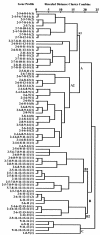Virulence characteristics and molecular epidemiology of enteroaggregative Escherichia coli isolates from hospitalized diarrheal patients in Kolkata, India
- PMID: 15364997
- PMCID: PMC516302
- DOI: 10.1128/JCM.42.9.4111-4120.2004
Virulence characteristics and molecular epidemiology of enteroaggregative Escherichia coli isolates from hospitalized diarrheal patients in Kolkata, India
Abstract
Enteroaggregative Escherichia coli (EAEC) is an important diarrheal enteropathogen defined by aggregative adherence to cultured epithelial cells. We have detected EAEC from 121 (6.6%) of 1,826 hospitalized patients admitted with diarrhea to the Infectious Diseases Hospital in Kolkata, India. Watery diarrhea was recorded significantly (P = 0.0142) more often in children. The majority of the EAEC isolates were not serotypeable (62%) and showed resistance to five or more antibiotics (76%). We studied different virulence genes and the molecular epidemiology of 121 EAEC isolates recovered from diarrheal patients. A PCR assay for detection of virulence genes, an assay for determination of clump formation in liquid culture, and a HeLa cell adherence assay were carried out to characterize the EAEC isolates. Investigations were also conducted to correlate the virulence gene profiles with diarrheal symptoms and molecular epidemiology by pulsed-field gel electrophoresis (PFGE). Two or more virulence genes were detected in 109 (90.1%) EAEC isolates. In the cluster analysis, some isolates with specific gene profiles and phenotypes formed a group or subcluster. This study highlights the comparative distributions of three fimbrial adhesins and other virulence genes among EAEC isolates. The diverse virulence gene and PFGE profiles, along with the existence of diverse serotypes and antibiograms, suggests that the EAEC isolates are genetically heterogeneous in Kolkata.
Figures



Similar articles
-
Molecular Epidemiology of Enteroaggregative Escherichia coli (EAEC) Isolates of Hospitalized Children from Bolivia Reveal High Heterogeneity and Multidrug-Resistance.Int J Mol Sci. 2020 Dec 15;21(24):9543. doi: 10.3390/ijms21249543. Int J Mol Sci. 2020. PMID: 33334000 Free PMC article.
-
Phenotypic and genotypic characterization of enteroaggregative Escherichia coli isolates from pediatric population in Pakistan.APMIS. 2016 Oct;124(10):872-80. doi: 10.1111/apm.12577. Epub 2016 Aug 2. APMIS. 2016. PMID: 27485156
-
Genetic Virulence Profile of Enteroaggregative Escherichia coli Strains Isolated from Danish Children with Either Acute or Persistent Diarrhea.Front Cell Infect Microbiol. 2017 May 30;7:230. doi: 10.3389/fcimb.2017.00230. eCollection 2017. Front Cell Infect Microbiol. 2017. PMID: 28611957 Free PMC article.
-
Enteroaggregative Escherichia coli an emergent pathogen with different virulence properties.Rev Latinoam Microbiol. 2005 Jul-Dec;47(3-4):140-59. Rev Latinoam Microbiol. 2005. PMID: 17061538 Review.
-
Enteroaggregative Escherichia coli: epidemiology, virulence and detection.J Med Microbiol. 2007 Jan;56(Pt 1):4-8. doi: 10.1099/jmm.0.46930-0. J Med Microbiol. 2007. PMID: 17172509 Review.
Cited by
-
Pathotypes of diarrheagenic Escherichia coli in children attending a tertiary care hospital in South India.Diagn Microbiol Infect Dis. 2010 Oct;68(2):117-22. doi: 10.1016/j.diagmicrobio.2010.06.003. Diagn Microbiol Infect Dis. 2010. PMID: 20846583 Free PMC article.
-
Characterization of Diarrheagenic Enteroaggregative Escherichia coli in Danish Adults-Antibiotic Treatment Does Not Reduce Duration of Diarrhea.Front Cell Infect Microbiol. 2018 Sep 27;8:306. doi: 10.3389/fcimb.2018.00306. eCollection 2018. Front Cell Infect Microbiol. 2018. PMID: 30319991 Free PMC article.
-
Genomic characterization of enteroaggregative Escherichia coli from children in Mali.J Infect Dis. 2012 Feb 1;205(3):431-44. doi: 10.1093/infdis/jir757. Epub 2011 Dec 19. J Infect Dis. 2012. PMID: 22184729 Free PMC article.
-
Phenotypic and Genotypic Characterization of Enteroaggregative Escherichia coli Strains Isolated From Diarrheic Children in Iran.Jundishapur J Microbiol. 2015 Sep 8;8(9):e22295. doi: 10.5812/jjm.22295. eCollection 2015 Sep. Jundishapur J Microbiol. 2015. PMID: 26487919 Free PMC article.
-
Genotypic and phenotypic characterization of enteroaggregative Escherichia coli (EAEC) isolates from diarrheic children: An unresolved diagnostic paradigm exists.Iran J Basic Med Sci. 2020 Jul;23(7):915-921. doi: 10.22038/ijbms.2020.42119.9959. Iran J Basic Med Sci. 2020. PMID: 32774814 Free PMC article.
References
-
- Adachi, J. A., Z. D. Jiang, J. J. Mathewson, M. P. Verenkar, S. Thompson, F. Martinez-Sandoval, R. Steffen, C. D. Ericsson, and H. L. DuPont. 2001. Enteroaggregative Escherichia coli as a major etiologic agent in traveler's diarrhea in 3 regions of the world. Clin. Infect. Dis. 32:1706-1709. - PubMed
-
- Bauer, A. W., W. M. Kirby, J. C. Sherris, and M. Turck. 1966. Antibiotic susceptibility testing by a standardized single disk method. Am. J. Clin. Pathol. 45:493-496. - PubMed
-
- Bhan, M. K., P. Raj, M. M. Levine, J. B. Kaper, N. Bhandari, R. Srivastava, R. Kumar, and S. Sazawal. 1989. Enteroaggregative Escherichia coli associated with persistent diarrhea in a cohort of rural children in India. J. Infect. Dis. 159:1061-1064. - PubMed
Publication types
MeSH terms
Substances
LinkOut - more resources
Full Text Sources
Medical

